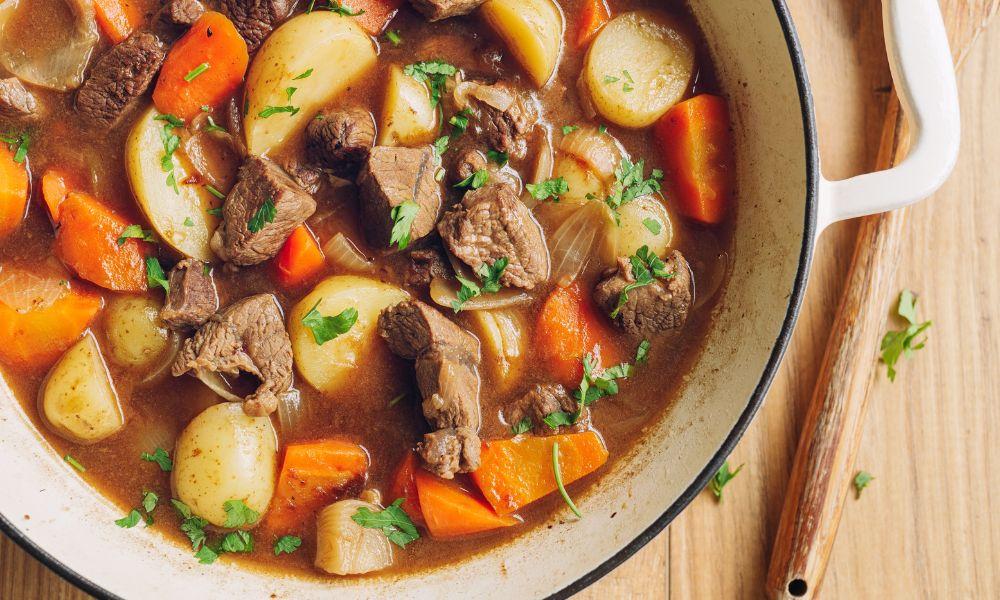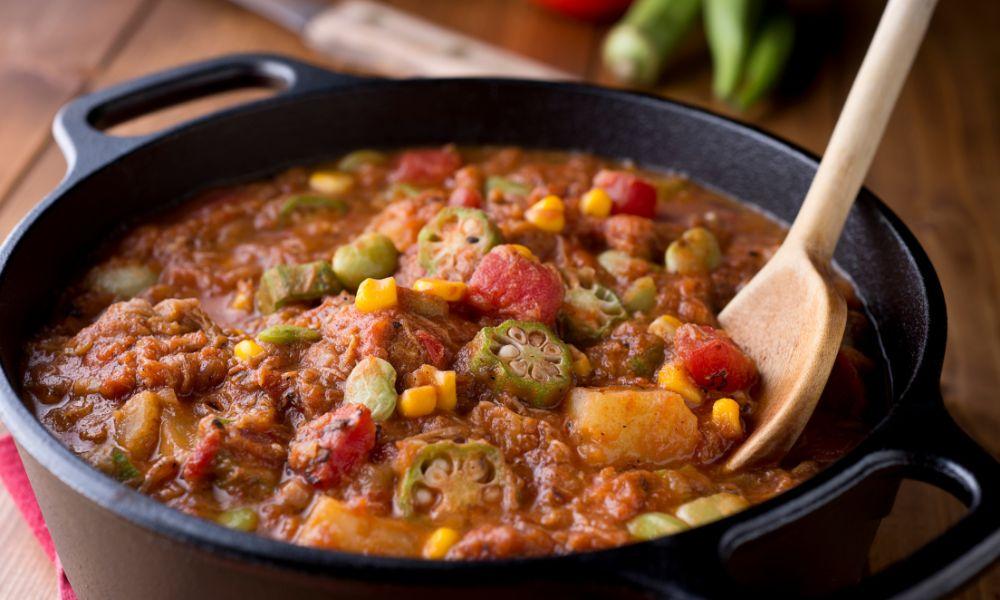What’s more comforting than a delicious bowl of stew on a chilly evening? This classic, versatile dish is a fan favorite worldwide. Sometimes we find ourselves with too much of a good thing, leaving us wondering, “How long is stew good in the fridge?” Fear not! We’ve got you covered. This article will explore how long you can safely store stew and ensure it stays fresh and full of flavor.

Understanding Stew Shelf Life
We often think of stew as a warm, wholesome concoction of meat and vegetables swimming in a delicious broth or gravy. However, the world of stews is much more diverse, with various types and variations based on regional cuisine and available ingredients. Whatever your preference, it’s essential to understand how the shelf life of stew is influenced by factors like ingredients, cooking methods, and storage conditions.
Not all stews are created equal – some may have a longer shelf life than others. For instance, meat-based stews (e.g., beef or chicken) may spoil faster than a vegetarian stew. Regardless of the stew you’re dealing with, following recommended guidelines for safe food handling and storage is crucial to keep yourself and your loved ones healthy.
How Long Does Stew Last in the Fridge?
| Type of Stew | Approximate Shelf Life in Fridge | Optimal Refrigeration Temperature |
|---|---|---|
| Chicken or Beef Stew | About 3 days | 40°F (4°C) |
| Vegetarian Stew | 4-5 days | 40°F (4°C) |
So, how long is stew good in the fridge? The answer varies depending on factors such as the type of stew and the ingredients used. As a general rule of thumb, you can store cooked stew in the fridge for up to three to four days. From my own experience, I noticed that stews with meat, like chicken stew and beef stew, tend to be good in the fridge for about three days, while vegetarian stews may last a day or two longer.
Proper refrigeration temperature plays a significant role in extending the freshness of your stew. Did you know that the optimal temperature to store stew in the fridge is around 40°F (4°C)? Maintaining this temperature ensures that any potential bacterial growth is minimized, preserving your leftover stew’s flavor and tenderness.
Signs of Spoiled Stew

Safety first! Before diving into your delicious leftover stew, it’s vital to ensure that it hasn’t gone bad or spoiled. Several signs can indicate whether your refrigerated stew is safe to consume or not. Keep an eye out for:
- Unusual discoloration: If you spot a change in the stew’s color (e.g., grey or brown patches), it’s probably past its prime. Remember, good stew should still look as fresh as the day you made it.
- Off-putting smell: Trust your nose. If your stew emits a foul or sour odor, discard it immediately. A fresh stew should have an inviting, well-seasoned aroma.
- Mold growth: Mold can develop on the surface of spoiled stew. If you spot any fuzzy-looking patches, play it safe and throw the stew away.
The risk of foodborne illnesses isn’t worth the risk of consuming spoiled stew. So, always err on the side of caution and discard any stew that looks or smells “off.”
Storing Stew in the Fridge
To maximize your leftover stew’s shelf life, follow these step-by-step instructions for storing homemade stew in the fridge:
- Allow the stew to cool: A common mistake is refrigerating hot stew immediately after cooking. Instead, let the stew cool to room temperature (within two hours) before putting it in the fridge. This prevents the risk of bacterial growth and condensation within the storage container.
- Use airtight containers or storage bags: Whatever container you choose – glass, plastic, or even aluminum foil – ensure it’s airtight to prevent contamination and maintain freshness. I’ve found that storing stew in glass containers with secure lids works best for me.
- Label your containers: It’s helpful to label your containers with the date you cooked the stew and the type of stew it contains. This makes it easy to identify which stew is nearing its expiration to prevent storing unopened stew for too long.
- Organize your storage: Place your stew containers in the main body of the fridge, not the door compartments. This position ensures the stew stays at a consistent temperature without exposure to the fluctuations caused by opening and closing the fridge.
👩🍳Pro tip: To make your stew easy to reheat, consider storing it in smaller portions. It also minimizes the risk of multiple reheating cycles and promotes even heating.
Tips for Safe Consumption and Reheating

With your stew safely stored, it’s essential to know the best practices for consuming and reheating it. When it comes to reheating refrigerated stew, there are several safe methods available:
- Stovetop: This method allows for even reheating and excellent control over the temperature. Warm the stew on medium heat, stirring occasionally to ensure uniform heating throughout.
- Microwave: Reheat your stew in a microwave-safe container, covered, using the reheat setting or at 50-60% power. Stir the stew every couple of minutes to distribute the heat evenly throughout.
- Oven: Preheat your oven to 325°F (165°C) and place your stew in an oven-safe container. Allow it to heat for 20-30 minutes, checking and stirring occasionally to ensure the stew heats evenly.
It’s worth noting that minimizing multiple reheating cycles is crucial to maintaining the safety and flavor of your stew. Repeated heating and cooling can encourage bacterial growth, increasing the risk of foodborne illness. If possible, try to reheat only what you plan on consuming to prevent wasting your delicious stew.
FAQs
Can you freeze stew to extend its shelf life?
Yes! Freezing leftover stew is an excellent option to prolong its shelf life. Well-frozen stew can last up to three months in the freezer without losing its quality.
How should you defrost frozen stew before reheating?
You can safely thaw your frozen stew by placing it in the fridge to thaw overnight or using the defrost option on your microwave. Also, check out our tips on how to defrost frozen meat.
What is the optimal temperature to store stew in the fridge?
The ideal temperature to store stew in the fridge is around 40°F (4°C). It minimizes bacterial growth and prolongs the stew’s freshness.
Can you keep stew in the fridge for a week?
As a general guideline, stew should be consumed within three to four days. However, use your judgment based on the appearance, smell, and taste of the stew.
How can you tell if stew is still good after several days in the fridge?
Visually inspect the stew for any discoloration or mold growth. Additionally, trust your senses and check the aroma and taste before consuming.
Can you store stew with potatoes or other vegetables in the fridge?
Yes, you can store stews containing potatoes and other vegetables – just make sure to follow proper storage practices and consume within the recommended time frame.
Is it safe to consume stew with a slightly sour smell?
A sour smell might be a sign that your stew has gone bad. Play it safe and discard it to avoid the risk of foodborne illness.
How long does homemade stew last in the refrigerator compared to store-bought?
Homemade stews can generally be stored in the refrigerator for three to four days, while store-bought stews may contain preservatives that allow them to last a bit longer. Always check the label and use-by date.
Can you store stew with gravy in the fridge?
Absolutely! Stews containing gravy can be stored and reheated following the same guidelines as mentioned earlier.
Conclusion
Now that we’ve uncovered the secrets of stew storage and got the answer to how long stew is good in the fridge, you can confidently enjoy your favorite steaming bowl of comforting goodness without worrying about spoilage or loss of quality. Implement these essential storage tips and savor your stew leftovers for days. Bon appétit!
References:
- U.S. Food & Drug Administration (FDA): Food Storage Tips
- Centers for Disease Control and Prevention (CDC): Four Key Steps to Food Safety
- U.S. Department of Agriculture (USDA): Safe Food Storage – The Cupboard
- U.S. Department of Agriculture (USDA): Safe Food Storage – The Refrigerator and Freezer
- U.S. Department of Agriculture (USDA): Safe Minimum Cooking Temperatures Chart
- U.S. Department of Agriculture (USDA): Food Product Dating